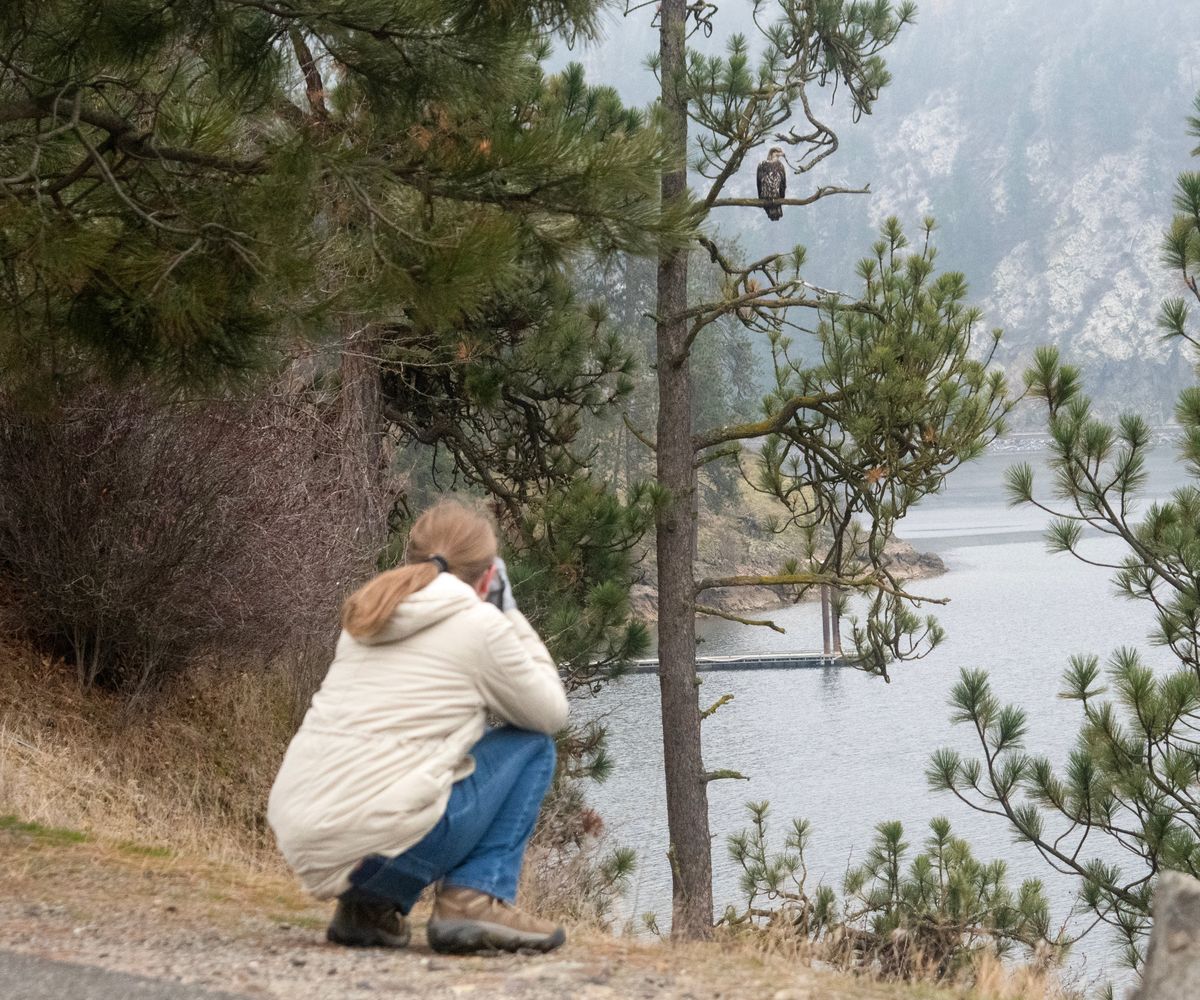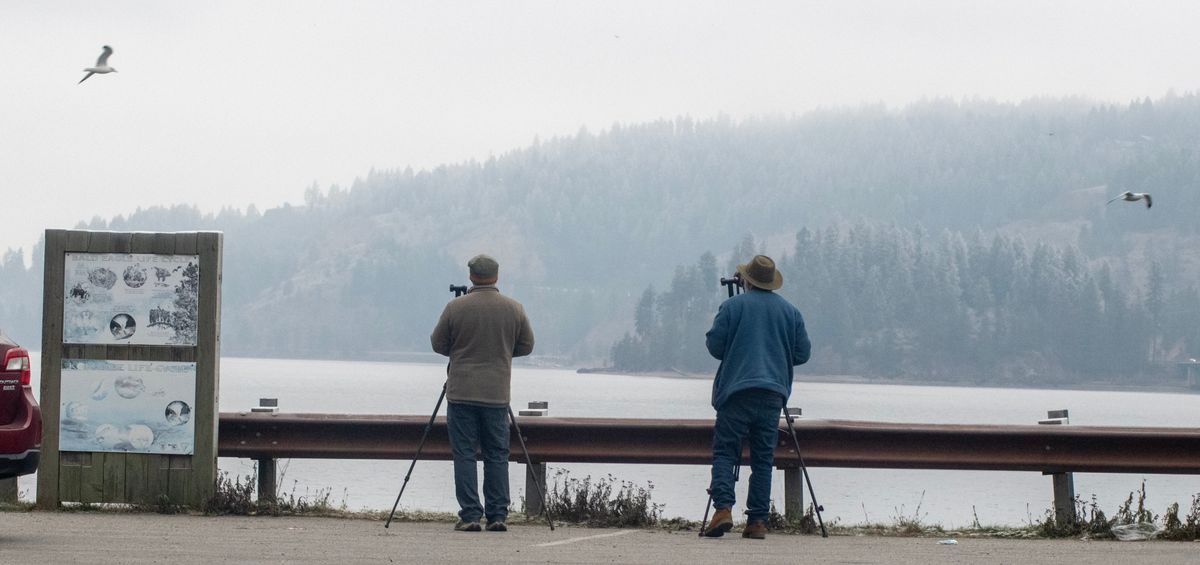Wing watch: Tracking the annual gathering of bald eagles at Lake Coeur d’Alene
Whitney Larsen of Post Falls photographs an immature bald eagle sitting in a snag above Lake Coeur d’Alene on Wednesday. (Michael Wright/THE SPOKESMAN-REVIEW)
Carrie Hugo has an eagle eye.
She can spot them in trees near and far. She knows their shape when they fly over the water. Even in heavy snow, she can pick out the head of a bald eagle.
“Those white heads are like a beacon for me,” she said.
Occasionally, people wonder aloud why she’s so good. The answer is simple: experience.
Beginning in November each year, Hugo, a biologist with the Bureau of Land Management, drives the same 12-mile route along Lake Coeur d’Alene roughly once a week, counting the eagles perched in trees above the water.
The counts, which are posted publicly online, give people a sense of the number of birds out on the lake. It’s also the continuation of nearly five decades of effort by the BLM to track the annual arrival of eagles, which return to the lake each winter to feed on spawning kokanee salmon.
It’s a well known and popular spectacle, one that draws bird watchers and wildlife photographers from around the region to the east side of Lake Coeur d’Alene. On good days, they see bald eagles by the dozen.
“It’s pretty cool to see that many eagles that close up,” Madonna Luers of the Spokane Audubon Society said. “It makes you think you live in Alaska.”
The annual show is also a reminder of the species’ remarkable recovery after human influence brought them to the brink of extinction in the U.S. in the middle of the 20th century. Laws against killing them and a ban on DDT helped make conservation efforts successful, and now the birds are relatively abundant.
In 2020, the U.S. Fish and Wildlife Service estimated there were about 316,000 in the Lower 48 states.
The BLM started tracking the throngs of eagles at Lake Coeur d’Alene in 1974. There are some resident bald eagles in the Coeur d’Alene area, but the big congregation that happens each November and December is mostly made up of travelers, birds searching for easy food.
At Lake Coeur d’Alene, they find open water and an abundance of spawning kokanee salmon.
Kokanee, which are landlocked sockeye salmon, aren’t native. The Idaho Department of Fish and Game first stocked kokanee in the lake in 1937.
They’ve done well, and they’ve become a crucial part of the machinations of Lake Coeur d’Alene. Eagles eat them, but so do the lake’s smallmouth bass and chinook salmon. Anglers fish for them and take them home.
“Kokanee kind of support the whole thing,” said Mike Thomas, a fisheries biologist for Idaho Fish and Game.
There are millions of them, but the fish do go through boom and bust cycles. The most recent low counts came in 2018, when Idaho Fish and Game estimated there were between 2 million and 4 million of them.
The population has since rebounded. The most recent estimate was roughly 10 million, though Thomas cautions that the number isn’t an exact count.
The rebound means the fish are smaller. When counts were low, the fish that were in the lake grew to an average of roughly 15 inches, with some growing as long as 18 inches. This year, Thomas said most adult fish – those 3 and 4 years old – are about 10 inches long.
Lake Coeur d’Alene’s kokanee are considered “late” spawners, one of two strains of the landlocked salmon. Late spawners don’t turn red, and instead of running up rivers, they lay their eggs in gravel in shallow water near the lake’s edge. Like other salmon, once they spawn, they die.
“When it comes time to do their thing, they’re clocking out at the end of the show,” Thomas said. “That’s what you’re seeing that’s feeding a lot of the eagles, too.”
The best spawning habitat is along the east side of the lake, throughout Wolf Lodge Bay. And, once spawning begins in November, that’s the best place to find eagles.
The birds will be around as long as there are fish to eat. Hugo starts hearing from birders and photographers in the fall, people from out of town who want to know if the eagles have arrived .
Hugo took over the eagle counts when she went to work for the BLM in 2009.
She takes the same route as her predecessor, stopping at several places to use binoculars to meticulously scan the south shore for white heads, counting from right to left. In her most recent count, she saw 68 eagles at one of her stops.
In certain spots, she’ll count as she drives. She waits to pull out of a parking lot until no one is behind her, and then she drives slowly and scans the treetops, keeping track of adult and juvenile eagles in her head.
When she reaches the next parking lot, she jots the numbers down.
It’s not a perfect science. Some amount of double counting is bound to happen – eagles don’t sit still all morning, waiting for her to show up, and some of them might fly from one of her early stops to her last one by the time she gets there.
“It’s really just a trend,” Hugo said. “Are they going up? Are they going down? Are there lots this year? Are there not very many this year?”
The numbers seem to increase with each week in November. On Nov. 8, Hugo saw two eagles. Eight days later, she was up to 29. She logged 110 the day before Thanksgiving, and on Monday, she had her highest count so far this year: 181.
Predicting when the eagle gathering will peak has become tougher. Hugo said it used to be easy: on or around Dec. 21. It was so solid the BLM planned its annual Eagle Watch event around it.
She feels like it’s changed in the past few years, shifting a week or so earlier – this year, they’re holding an Eagle Watch event on Dec. 15 and 16.
But even in the past few years, the dates of her highest counts have varied.
Last year her highest count came on Dec. 28. The year prior, it was Dec. 14. In 2019 and 2020, the peak landed on Dec. 2.
Whenever it comes, Hugo will be there.
So will a lot of other people. On Wednesday, the parking lot at Higgens Point was nearly full.
People walked a trail down to a beach with a dock, where they could look back toward the shore.
At the Mineral Ridge boat ramp, two men stood behind their tripods, waiting for action, and appearing to be ready to wait all day if they had to.
It’s a dedicated crowd.
“They’re out before I am,” Hugo said.








